Eliza Ashton facts for kids
Quick facts for kids
Eliza Ashton
|
|
|---|---|

Painting of Eliza Ashton in New South Wales, Australia 1880
|
|
| Born |
Eliza Ann Pugh
1851/1852 Stoke Newington, London, England
|
| Died | (aged 48) |
| Burial place | Waverley |
| Other names | Faustine, Mrs Julian Ashton |
| Occupation | Journalist |
| Years active | 1889 – 1900 |
| Spouse(s) | Julian Ashton |
| Children | 5 |
Eliza Ann Ashton (born Pugh, 1851 or 1852 – July 15, 1900) was a journalist and social reformer from England who moved to Australia. She wrote for big newspapers in Sydney, like The Sydney Morning Herald and The Daily Telegraph. She used different pen names, such as Faustine and Mrs Julian Ashton. Eliza was also one of the people who helped start the Womanhood Suffrage League in New South Wales, which worked for women's right to vote.
Contents
Eliza Ashton's Early Life
Eliza Ann Pugh was born in Stoke Newington, England. This was in either 1851 or 1852. Her father worked as a manager at a company called J.S. Morgan & Co. Eliza went to a girls' college in North London. After that, she studied at a boarding school in France.
On August 1, 1876, she married an artist named Julian Ashton. Two years later, in 1878, they moved together to Australia.
Eliza Ashton's Journalism Career
Eliza Ashton worked as a journalist, writer, and literary critic. She wrote for major newspapers in Sydney. These included The Sydney Morning Herald and The Daily Telegraph. She also wrote an article about how girls were educated for the Centennial Magazine.
Writing Under Different Names
Eliza used two main pen names for her writing. As Faustine, she mostly wrote about social issues and ideas. When she wrote as Mrs Julian Ashton, she was known for her sharp literary reviews. A writer in Table Talk described her as a "practical philosopher." This meant she liked to think about real-world problems.
Working for Social Change
Eliza Ashton was very active in working for social improvements. She was a committee member of the Women's Literary Society in Sydney. She also helped to start the Womanhood Suffrage League of New South Wales. This group worked to give women the right to vote.
Debating Marriage Laws
At a meeting of the Womanhood Suffrage League on November 11, 1891, Eliza presented a paper. In this paper, she suggested big changes to marriage laws. One idea was that married couples should renew their vows every year. If either person refused, they would get an automatic divorce.
This idea caused a lot of discussion and criticism in the newspapers. Lady Jersey, whose husband was the Governor of New South Wales, was one of her critics. Lady Jersey stopped Eliza from visiting Government House. This was a problem for Eliza's work as a journalist. Lady Jersey also asked the League to distance themselves from Eliza's views.
The League's secretary, Rose Scott, quickly said that the League did not agree with Eliza's ideas on marriage. However, Eliza remained a member of the League.
Defending Her Ideas
Eliza's husband, Julian Ashton, defended her views in a letter on November 16. He said he was surprised that society couldn't discuss the topic calmly. On November 25, Eliza's own letter was published in The Daily Telegraph and The Sydney Morning Herald. She wrote that the public's reaction was a "storm of abuse and misrepresentation." She also published the full text of her paper. She challenged readers to find where she had supposedly supported the extreme ideas they were criticizing.
On April 10, 1892, Eliza Ashton gave another talk about marriage. The Daily Telegraph summarized her speech. Later that month, The Kerang Times also shared her ideas. This led to more criticism from other newspapers, like The Evening News.
On April 26, Eliza wrote an article under the name L. A. Ashton. She described a debate she had with Rose Scott and Frank Cotton. They were a politician from the Labour party. Even though they disagreed with her, Eliza liked their polite way of debating. She preferred this to the rude and anonymous comments she had received from others.
In 1899, Lady Jersey wrote to the new Governor's wife, Lady Beauchamp. She suggested that Eliza Ashton should be allowed to visit Government House again. Lady Jersey explained that she had felt she had to speak out against Eliza's public views. However, she had never heard anything bad about Eliza's personal character.
Despite all the criticism, Eliza Ashton kept working as a journalist. She continued writing until just a week before she passed away in 1900.
Eliza Ashton's Family Life
Eliza Ashton had five children with her husband, Julian Ashton.
- Julian Howard Ashton (born August 9, 1877 – died April 30, 1964) also became an artist and a journalist.
- Percival George Ashton (born 1879) was later known as Captain Percy Ashton.
- Bertha Rossi Ashton (born 1882 – died February 6, 1970) married William Charlton Hubble in July 1923.
- Rupert Ashton (born 1885 – died March 4, 1895) passed away when he was young.
- Arthur Roy Ashton (born 1886 – died October 2, 1917) was killed in action in Belgium during a war.
Eliza Ashton's Death
On July 11, 1900, Eliza Ashton became very ill. She fell unconscious the next day. Her health got worse, and she died on July 15, 1900. The cause of her death was a brain haemorrhage. She was buried at Waverley Cemetery.
See also
 In Spanish: Eliza Ashton para niños
In Spanish: Eliza Ashton para niños

